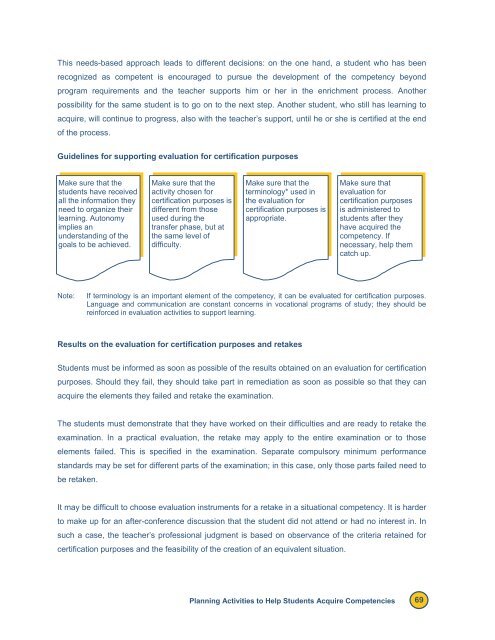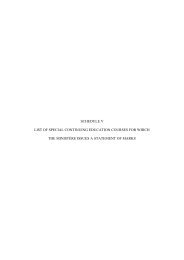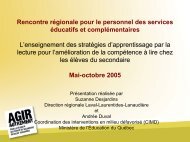Reference Framework for Planning Learning and Evaluation Activities
Reference Framework for Planning Learning and Evaluation Activities
Reference Framework for Planning Learning and Evaluation Activities
You also want an ePaper? Increase the reach of your titles
YUMPU automatically turns print PDFs into web optimized ePapers that Google loves.
This needs-based approach leads to different decisions: on the one h<strong>and</strong>, a student who has been<br />
recognized as competent is encouraged to pursue the development of the competency beyond<br />
program requirements <strong>and</strong> the teacher supports him or her in the enrichment process. Another<br />
possibility <strong>for</strong> the same student is to go on to the next step. Another student, who still has learning to<br />
acquire, will continue to progress, also with the teacher’s support, until he or she is certified at the end<br />
of the process.<br />
Guidelines <strong>for</strong> supporting evaluation <strong>for</strong> certification purposes<br />
Make sure that the<br />
students have received<br />
all the in<strong>for</strong>mation they<br />
need to organize their<br />
learning. Autonomy<br />
implies an<br />
underst<strong>and</strong>ing of the<br />
goals to be achieved.<br />
Make sure that the<br />
activity chosen <strong>for</strong><br />
certification purposes is<br />
different from those<br />
used during the<br />
transfer phase, but at<br />
the same level of<br />
difficulty.<br />
Make sure that the<br />
terminology* used in<br />
the evaluation <strong>for</strong><br />
certification purposes is<br />
appropriate.<br />
Make sure that<br />
evaluation <strong>for</strong><br />
certification purposes<br />
is administered to<br />
students after they<br />
have acquired the<br />
competency. If<br />
necessary, help them<br />
catch up.<br />
Note:<br />
If terminology is an important element of the competency, it can be evaluated <strong>for</strong> certification purposes.<br />
Language <strong>and</strong> communication are constant concerns in vocational programs of study; they should be<br />
rein<strong>for</strong>ced in evaluation activities to support learning.<br />
Results on the evaluation <strong>for</strong> certification purposes <strong>and</strong> retakes<br />
Students must be in<strong>for</strong>med as soon as possible of the results obtained on an evaluation <strong>for</strong> certification<br />
purposes. Should they fail, they should take part in remediation as soon as possible so that they can<br />
acquire the elements they failed <strong>and</strong> retake the examination.<br />
The students must demonstrate that they have worked on their difficulties <strong>and</strong> are ready to retake the<br />
examination. In a practical evaluation, the retake may apply to the entire examination or to those<br />
elements failed. This is specified in the examination. Separate compulsory minimum per<strong>for</strong>mance<br />
st<strong>and</strong>ards may be set <strong>for</strong> different parts of the examination; in this case, only those parts failed need to<br />
be retaken.<br />
It may be difficult to choose evaluation instruments <strong>for</strong> a retake in a situational competency. It is harder<br />
to make up <strong>for</strong> an after-conference discussion that the student did not attend or had no interest in. In<br />
such a case, the teacher’s professional judgment is based on observance of the criteria retained <strong>for</strong><br />
certification purposes <strong>and</strong> the feasibility of the creation of an equivalent situation.<br />
<strong>Planning</strong> <strong>Activities</strong> to Help Students Acquire Competencies 69




